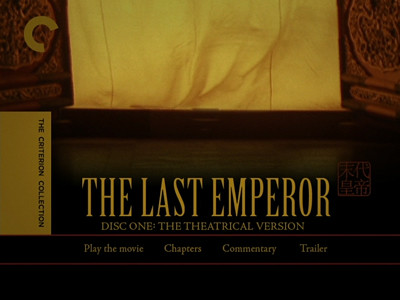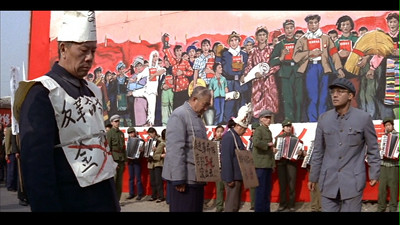
Bernardo Bertolucci's The Last Emperor is epic in every sense of the word. Sprawling in both running time and narrative time, it covers several decades of history, following the travails of one man and the grand events that dictate not only the course of his life, but affect the world stage. In 1988, the international production swept the Oscars, and has since stood the test of time, its gorgeous filmmaking still as impressive today as it was twenty years ago. Now, at long last, the movie is also getting the epic DVD treatment with the new 4-disc The Last Emperor - The Criterion Collection.
The Last Emperor is Pu Yi of China. Taken to the Forbidden City in 1908, the boy was crowned at the age of 3 at a time when the monarch was not permitted to leave the massive royal estate (it was called a "City" for a reason) as a matter of tradition. Before the new king even reached puberty, however, his nation changed underneath him, becoming a Republic and electing its own president. Very little changed for Pu Yi as far as his way of living. He was still surrounded by courtiers of whom he could make any demand, he just didn't have any sway over public policy. He was also now confined to his portion of the Forbidden City as a prisoner.
Bertolucci and screenwriter Mark Peploe explore the life of Pu Yi on two divergent timelines. The narrative of his growth from child king to empty figurehead regularly jumps forward to a framing timeline in the 1950s when Pu Yi was imprisoned by the Communists. Played as an adult by John Lone in both story lines, we see that the Emperor is a man who only knows a life of privilege and it takes a long time for him to lose the belief that it is his God-given right to rule. Though the Communist government's intention is to recondition Pu Yi and make him a productive member of their new society, they unwittingly end up serving as the final catalyst for turning a boy into a man.
Though Pu Yi left palace life as a young man, he was still very much a child. Not privy to the regular rites of passage experienced by most youths, his views of life all come second-hand, from his courtiers, from books and magazines, and from his British tutor, Reginald Johnston (Peter O'Toole). Pu Yi is married, but his conception of love is extremely adolescent. He has two wives: his true spouse Wan Jung (Joan Chen) and, essentially, his mistress, Wen Hsiu (Wu Jun Mei). He sleeps with them simultaneously, walks around with one on each arm, but has no conception that the Western world he longs to flee to would not look favorably on his living arrangements. When Wen Hsiu leaves him, he has no idea why.

This same naïveté is what also caused him to become a stooge of the Japanese, betraying China and helping its enemies set up a puppet government in Manchuria. By the end of WWII, Pu Yi realizes he has been duped, and Japan's loss of the war is what eventually leads to his imprisonment under the Reds. The heartbreak of adult life is visited on the child with explosive vigor.
And yet, by the end of his life, Pu Yi has become a real man, one who enjoys simple pleasures and has compassion for others. It's a hard-won transformation, but it's also a true one.
Bertolucci imbues The Last Emperor with an ostentatious splendor befitting his majestic subject. The sheer size of the Forbidden City demands that any production set inside it go large. The storytelling style could be compared favorably to the epics made by David Lean, though with less romanticism and stronger strains of real-world practicality. Pu Yi is never going to be a great hero, and his immaturity ends up being counterintuitive to his having a passionate romance, but his metamorphosis is almost like an epic in reverse, moving from grand illusion to peaceful actuality.
From the starting frame to the last, The Last Emperor is a beautiful movie. The multiple art directors, production designer, and costume designer have recreated the world of early 20th-century China. Vittorio Storaro's camera and his stunningly generous eye capture the rich colors and costumes with an exacting, unwavering attention. The cinematographer works across the open film, letting every frame burst with detail. It's a complete illusion. You are not only viewing the story, but you are there.

DVD 1 contains the 165-minute theatrical version of the film, which the director considers to be his preferred cut. The second disc is the 218-minute television cut, which isn't longer in order to restore pieces the Bertolucci had to remove against his will or better judgment, but simply a longer version made to take up more airtime and run as a TV event. (This also means removing the few instances of swearing.)
Essentially, it's the same film in structure and content. Some scenes are longer, and then some new elements are added, particularly in the prison sequences. For instance, in terms of extended scenes, Reginald Johnston's arrival is filled out with a conversation between the English tutor and the man he is replacing, Chen Paoshen (Victor Wong), in the car on the way to the palace. It serves to emphasize the sympathies of the Chinese teacher, who always had Pu Yi's best interests at heart, and thus brought Johnston as an aid for his young charge. Elsewhere, as an example of an added scene, we have a flashback where Pu Yi's wet nurse (Jade Go) tells the young monarch how she got her job. Other bits are far less substantial, just a reversed nip or tuck here and there.
In both cases, the restored footage adds color to the story, and The Last Emperor is still quite excellent in its longer form; nevertheless, the additions are neither crucial nor necessary. Comparing the two cuts actually shows how a good director and his editor can shape a movie into a stronger narrative by working out what is essential. The theatrical cut is a sharper picture, not as prone to meandering, and is arguably the better for it.

For technical specs and special features, read the full article at DVD Talk.

8 comments:
You've reminded me what a wonderful film this is. Now I can't wait to see it again.
Whoo! My first comment here! And from the esteemed Mr. Acito!
Can you believe I had never seen this movie before last week? It was a lot to digest, but it's everything it's always been said to be.
This version is cropped. For that reason I'd skip it. Criterion wrote a blog about it but I'm not buying it. The same thing was done when the Apocalypse Now DVD was released. What a shame.
Yeah, I addressed the cropping in the full review, and there is a link to the blog there. Having worked in a creative industry for most of my adult life, it never ceases to amaze me, though, when consumers somehow know better than the people who made the material. If Storaro says this is what he intended, than who can argue? Same thing happened with the coloring on Berlin Alexanderplatz and Days of Heaven; it's a shame that when the control of the look of a film is put back in the hands of those who made the film, segments of the audience try to tell them they can't have it how they want.
For those curious, what I wrote about the video:
Vittorio Storaro oversaw this new high-def transfer, preserving The Last Emperor at a 2.00:1 aspect ratio. I can find no fault with the job done, Criterion has clearly taken meticulous care to fully realize this sumptuous movie. The colors are fantastic, and the clarity of detail impeccable. The only possible complaint is that the original aspect ratio for the film is actually 2.35:1 (and 70 mm prints were 2.20), and so there has been some cropping; what may have been lost, if anything substantial, is not evident. (It also appears that the wider framing was never the wish of the filmmakers, as explained by Criterion: http://www.criterion.com/blog/2008_02_01_archive.html#1098242570263302949.)
By the by, for a more comprehensive discussion and comparison of the different aspect ratios, DVD Beaver is always a great source. They have screen comparisons of various releases.
I wanted to link to a great diary entry by Pete Townshend about people who argued with him over how Live at Leeds was mixed, based on their memory and their bootlegs, and his defense of his final say over his own music, but alas, it appears that his old journals are offline.
I have no problem with filmmakers tinkering with their work for DVD release. It’s a pretty common practice nowadays. What I don’t like in this Criterion release is that they DID NOT INCLUDE a version in its original aspect ratio. If it was a studio release I would have tolerated it more but this is Criterion -- its main customers are cineastes and film geeks like me who are very particular with these kinds of technicalities.
In my opinion Storaro’s reason for cropping his old films into 2:1 aspect ratio is in order to promote his "Univision" film system. There lies the madness…
Sorry, my friend, but we'll have to continue to disagree. I don't see the logic in that quibble. It makes no sense to me for Criterion to involve the creative team, get their stamp of approval, and then turn around and say, "Well, we're also going to release the movie in the way you don't want us to." Regardless of Storaro's reasoning, to then override it after getting him involved is counterintuitive. To me, that seems more like a move from a big studio.
Though, at the same time, I guess I also give you props if you put your money where your mouth is and don't buy it; again, hearkening to my work in comics, so many readers never vote with their wallets.
Thanks for contributing, whoever you are. I actually like that there is some discussion going on here. I do wish you'd at least sign a first name or something, though.
Criterion should then (slightly)revise their Mission Statement...
http://www.criterion.com/asp/about.asp
"...Each film is presented uncut, in its original aspect ratio, as its maker intended it to be seen."
Post a Comment